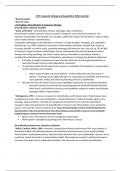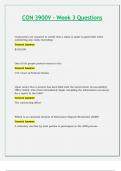MT4: Corporate Strategy and Acquisitions (Wk6 material)
*Recommended
~from Y1 notes
L11 Readings- Diversification & Corporate Strategy
Diversification rationale/ benefits
*Grant, 2019 (C12)- <diversification motives, advantage, data, relatedness>
Diversification motives: growth (revenue vs profit, in stagnant/ cash rich primary industry), risk
reduction (shareholders can diversify more cheaply, justified by cheaper internal finance, value of debt),
value creation (Porter's essential tests).
Competitive advantages of diversification: economies of scope (tangible, intangible, org. capabilities,
demand side, eg. LVMH/ Walmart), economies of internalising transactions (benefit from scope via
licensing, diversify to avoid tx costs), parenting advantage (add value the best, else sell, eg. GE sell NBC
to Comcast), internal markets (capital better access to information than external financiers, labour
cheaper than hiring and firing, save costs). Unclear data on diversified vs specialized, related vs
unrelated diversification performance. Relatedness: operational vs strategic (eg. Berkshire Hathaway)
Is it better to exploit economies of scope internally within the firm through diversification or
externally through contracts with independent companies?
Can licensing exploit the full value of the resource or capability? This depends, to a great extent,
on the transaction costs involved.
o Where property rights are clearly defined—as with trademarks and many types of
patents—licensing may be highly effective; for organizational capabilities and know ‐how
more generally, writing and enforcing licensing contracts is problematic.
Does the firm have the other resources and capabilities required for successful diversification?
o Starbucks' decision to terminate its licensing agreement with Kraft reflected Starbucks'
belief that it could build the resources and capabilities needed to market and distribute
packaged coffee to supermarkets.
*Montgomery, 1994- <3 views on reasons for diversification, performance data> Market-power view
(conglomerate power with cross-subsidisation, mutual forbearance, reciprocal buying), Agency view
(manager agency problems- diversify for managerial entrenchment to increase firm demand for
manager's skills and employment risk diversification), Resource view (firms deploy excess productive
factors, more specific resources diversify less). Data showing negative/ neutral relationship between
diversification/ M&A and performance, firms diversifying around specific resources more profitable
(support agency, resource. Not market-power view).
Agency view: also trying to increase managerial compensation
Market power: strengthen bargaining power (link Porters 5 forces)
Diversification performance (empirical evidence)
*Palich, Cardinal, Miller, 2000- <Inverted U-shaped diversification-performance link, meta-analysis> 3
theoretical models of relationship between diversification and performance: linear model (positive
linear relation, market power theory, internal market efficiency with cross-subsidization, resource view),
curvilinear models (inverted-U vs intermediate model). Data supports inverted U model (performance
increases from single unit to related diversification, then decreases for unrelated diversification).
,Berger & Ofek, 1995- <diversification reduces value, overinvestment, cross-subsidisation, tax> given
stand-alone value of individual business segments, diversification reduces value by 13-15% for 1986-
1991. Losses from tendency for diversified firms to overinvest and cross-subsidisation of poor
performing segments. Minor benefit from tax savings.
Villalonga, 2004- <diversification premium not discount> use of BITS data that is more consistent vs
segment data used in prior studies shows diversification premium that is robust to variations in sample
and definitions of business unit, excess value, and diversification. 2 plausible explanations: strategic
accounting (discount in COMPUSTAT is a result of strategic accounting practices in segment reporting
that reduce comparability across firms), relatedness (both findings are consistent- COMPUSTAT data
captures purely conglomerate unrelated diversification so conglomerate discount, but BITS capture
unrelated/related diversification, vertical integration)
Misc: extended thoughts on agency view, internal capital markets
*Barney, 2002 (C12)- <agency problems, monitoring/ bonding with structure, control systems,
compensation> Minimise manager-shareholder agency problems in corporate diversification strategy via
low-cost effective monitoring and bonding (policies that reassure shareholders decisions are made in
their interest) mechanisms: organisational structure (M-form, board of directors/ institutional investors
monitor, senior executive/ corporate staff monitor divisions and bond via strategy formulation),
management control processes (evaluating division performance, capital allocation across divisions,
transferring intermediate products), compensation policy (stock/ stock options)
Liebeskind, 2000- <internal capital markets benefits and costs> (1) limited circumstances where internal
capital markets add value (firms have trade secrets, external lenders are poorly informed, business have
programs sensitive to delay or interruption). These benefits accrue to capital constrained business units
from changes in lender type, for capital-sufficient businesses, centralisation of capital allocation mean
higher costs. Low chance of net benefit in firms with high % of capital sufficient businesses. (2)
comparative benefits/ costs of internal capital markets can be non-trivial, affecting value of diversified
firm beyond factors like economies of scope (3) relative efficiency of internal capital market depends on
organisational arrangements and changes in external capital markets (instability, innovations)
Purkayastha et al 2012- <internal capital markets important in EM/ new industries>
Capital markets are often bad in emerging markets, new high growth industries
o The internal capital markets argument could be particularly strong here
Economic downturns & recessions also help diversified companies benefit from the stabilising
effects of diversification
Other related- corp strat
~Porter, 1988- <corporate strategy> corporate (companywide) vs competitive (business unit) strategy.
Corporate strategies have been poor previously (>50% divestments of diversification acquisitions, worse
for unrelated diversification). Premises of corporate strategy: competition at the business level,
diversification is costly and constraining, shareholders can diversify themselves. Hence, only diversify if it
fits 3 essential tests (attractiveness, cost-of-entry, better-off). 4 concepts of corporate strategy: portfolio
management, restructuring, transferring skills, sharing activities.
Not important
,*Rumelt, 1982- <sources of association for diversification and profitability, economies of scope> Biases
in study of large firms: less diverse tend to have large market shares and thus better performance,
related diversified will have very productive core factors and thus better performance. Biases influence
study results, so they have no normative implications. Economies of scope occur if: there are increasing
returns, transaction costs prevent factor market, limits of factor utilisation given a single product
*Barney, 2002 (C11)- <motivations for diversification and sustained advantage> Motivations for
diversification include exploiting: economies of scope, financial economies of scope, anti-competitive
economies of scope, employee incentives to diversify. Rarity (no. of competitors exploiting same
economies of scope) and imitation (duplication/ substitution of economies of scope) affect ability of
diversification strategy to produce sustained advantage
Already covered in Grant, 2019 (C12) and Montgomery, 1994
Benner, 2007- <stock market reactions to firms' response to radical tech change, and effect on firms'
response> the greater the departure from the existing industry as a firm responds, the more negative
the stock market returns (worse for income vs growth stocks responding in era of ferment). Stock price
decrease causes decreased firm responsiveness to new tech, increased likelihood of spin-out to respond,
strategies to frame it as a complement not a substitute and attempts to change stock market identity.
Not useful
Teece et al. 1994- <coherence in diversification maintained> as US firms diversify, the coherence (extent
of relatedness of markets they diversify to) of each firm remains constant. Among firms, large
differences in degree of coherence caused by: enterprise learning, path dependencies, nature of
competitive environment.
Not useful
L12 Readings- Mergers & Acquisitions
M&A Reasons/ conditions for success:
*Capron & Pistre, 2002- <acquirer abnormal returns when they transfer unique resources to target,
value creation vs capture> only target's resources transferred to acquirer (no abnormal returns, bidding
competitors duplicate synergy, so bidding is competitive). Acquirer's resource transferred to target or
two-way (abnormal returns). Acquirer value capture depends less on absolute value creation and more
on bidder resource distribution (difference in 1st and 2nd bidder, if more similar, target captures value)
From lecture: Also depends on uniqueness of acquiree resource. If acquiring firm can achieve
unique synergies from many possible target firms, then it has bargaining power. Relative
bargaining power determines how value from synergies is split.
*Barney, 2002 (C14)- <M&A reasons, conditions for M&A superior profits, integration costs> No
superior profits in unrelated M&A, superior profits in related M&A captured by target's shareholders.
M&A takes place because of desire for survival, free cash flow, agency problems, managerial hubris,
possibility of economic profits. For bidder to gain economic profit/ competitive advantage, firm's link to
target must be based on resources that are (valuable, rare, and private or costly to imitate).
Unanticipated sources of relatedness can produce economic profits (not priced into bidding). Difficulties
and costs of integration must be discounted when valuing target.
Fridolfsson & Stennek, 2005- <mergers reduce profits but raise share price, pre-emptive mergers> if
mergers have strong negative externalities on firms outside the merger, firms may merge to pre-empt
(defend against) their partner merging with a rival. Share price increases given risk of being an outsider
is eliminated, but profit decreases as the merger is unprofitable.
, M&A Agency issues
*Hayward & Hambrick, 1997- <CEO hubris indicators, board control, acquisition premium, shareholder
loss> 4 indicators of CEO hubris are associated with large premiums: recent performance, media praise,
CEO's self-importance, composite of the 3. Strengthened relation when board has high % of inside
directors, when CEO is board chair. Delayed (1yr) losses in shareholder wealth: markets underestimate
negative effects initially, performance slippage in core business with focus on acquisition.
Wulf, 2004- <in mergers, target CEOs trade premium for power> on average, target firm shareholders in
mergers capture less gains. Target firm CEOs negotiate for more power in the post-merger entity with
shared governance in exchange for lower shareholder premiums (bad for shareholders). Could be self-
interest or for other non-shareholder stakeholder interests (employees etc.)
M&A in practice
*Haspeslagh & Jemison, 1987- <acquisitive strategy to create value over time is needed> acquisitive
strategies needed for success. Acquisitions are not ends in themselves, managers in practice try to
capture value immediately with asset stripping rather than create value over time. Strategic analysis is
just the first step in success, the pre- and post-acquisition process is more important. Acquisitions are
not ready-made solutions to problems, and value creation takes time.
From lecture: Integration is challenging and uncertain • Power shifts • Job insecurity • Policy
and procedure change • Resistance to change • Divided loyalties • Blurred roles and
responsibilities • Unclear reporting responsibilities • Infighting
Not important
Moeller, Schlingemann & Stulz, 2005- <data on acquirer shareholder profitability> 1990-1997
acquisitions were profitable in aggregate for acquirer shareholders. 1998-2001 saw large losses of
acquirer shareholders in aggregate, attributed to a small number (2%) of large loss deals. Poor
performance of these large loss firms afterward as they were mostly serial acquirers and investors
reconsider their high valuations after failure.
Chatterjee & Hambrick, 2007- <CEO narcissm and strategy/ performance> Empirical study shows
narcissism of CEOs positively relate to dynamism of strategy, number and size of acquisitions, and
performance that is more extreme and greatly fluctuating. narcissistic CEOs favour bold actions that
attract attention, resulting in big wins or big losses. Their firms' performance is generally no better or
worse than firms with non-narcissistic CEOs.
- Not directly related to M&A, covered sufficiently in Hayward & Hambrick, 1997
Jemison & Sitkin 1986- <issues with integration, rushing through deal>
Integration comes with issues: Buyer/seller conflicts exist, and these are often not resolved
before the acquisition closes. Different desires post-acquisition
Managerial momentum: Managers are caught up with the flow in an M&A deal and feel
pressured to complete the deal quickly. Investment banks facilitating the deal also have conflicts
of interest (they only get paid if the deal closes)
Too many fragmented perspectives: there exist strategic, legal, accounting, and financial
perspectives. Despite the involvement of a large variety of professionals from all fields, very
little time is spent on integrating the views, speed through the process.






